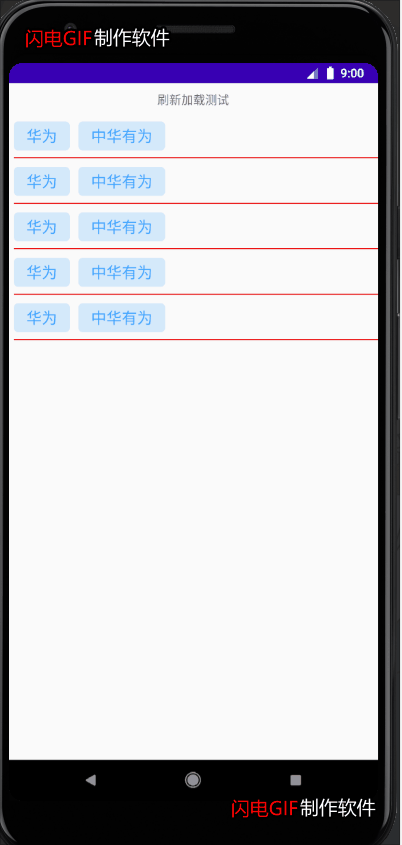昨夜西风凋碧树,独上高楼。望尽天涯路。
二更,之前一直在忙,本来说更新一下关于RecyclerView 的东西,但是给耽误了,下次一定要补上,今天所做的东西主要是我们在APP中经常用到的刷新功能和加载更多功能,在此之前需要了解SmartRefreshLayout,由于这个知识点很多,有时间再单独写一篇博客,这里默认你已经了解过并且知道怎么用了,了解SmartRefreshLayout请自行百度搜索。这篇文章主要记录一下实现刷新和加载的一个简单例子,代码很简单。先上效果图:

下面开始贴代码,首先是需要添加的依赖。
//recyclerview的依赖
implementation "androidx.recyclerview:recyclerview:1.1.0"
// For control over item selection of both touch and mouse driven selection
implementation "androidx.recyclerview:recyclerview-selection:1.1.0-rc01"
//smartrefresh以及经典的头部和尾部
implementation 'com.scwang.smartrefresh:SmartRefreshLayout:1.1.0'
implementation 'com.scwang.smart:refresh-header-classics:2.0.1'
然后是Mainactivity的布局代码
<LinearLayout
xmlns:android="http://schemas.android.com/apk/res/android"
xmlns:app="http://schemas.android.com/apk/res-auto"
xmlns:tools="http://schemas.android.com/tools"
android:layout_width="match_parent"
android:orientation="vertical"
android:layout_height="match_parent"
tools:context=".MainActivity">
<TextView
android:layout_marginTop="10dp"
android:layout_width="wrap_content"
android:layout_height="wrap_content"
android:text="刷新加载测试"
android:layout_gravity="center"
/>
<com.scwang.smartrefresh.layout.SmartRefreshLayout
android:id="@+id/smart"
android:layout_width="match_parent"
android:layout_height="match_parent"
android:layout_marginTop="6dp">
<com.scwang.smartrefresh.layout.header.ClassicsHeader
android:layout_width="match_parent"
android:layout_height="wrap_content" />
<androidx.recyclerview.widget.RecyclerView
android:id="@+id/test_rlv"
android:layout_width="match_parent"
android:layout_height="match_parent" />
<com.scwang.smartrefresh.layout.footer.ClassicsFooter
android:layout_width="match_parent"
android:layout_height="wrap_content" />
</com.scwang.smartrefresh.layout.SmartRefreshLayout>
</LinearLayout>
再来看看MainActivity的代码
public class MainActivity extends Activity {
private SmartRefreshLayout smartRefreshLayout;
private RecyclerView recyclerView;
private MyAdapter myAdapter;
private ArrayList<Data> list;
@Override
protected void onCreate(Bundle savedInstanceState) {
super.onCreate(savedInstanceState);
setContentView(R.layout.activity_main);
list=new ArrayList<>();
initData();
myAdapter=new MyAdapter(MainActivity.this,list);
recyclerView=findViewById(R.id.test_rlv);
recyclerView.setLayoutManager(new LinearLayoutManager(MainActivity.this));
recyclerView.setAdapter(myAdapter);
smartRefreshLayout=findViewById(R.id.smart);
smartRefreshLayout.setEnableLoadMore(true);
//监听下拉动作(也就是刷新)的监听器
smartRefreshLayout.setOnRefreshListener(new OnRefreshListener() {
@Override
public void onRefresh(@NonNull RefreshLayout refreshLayout) {
//刷新的逻辑是,每次触发刷新的动作时便重新请求一遍后端接口更新数据,
//本例中由于数据不是从后端动态获取的故不再刷新,直接结束刷新
smartRefreshLayout.finishRefresh();
}
});
//监听上滑动作(也就是加载更多)的监听器
smartRefreshLayout.setOnLoadMoreListener(new OnLoadMoreListener() {
@Override
public void onLoadMore(@NonNull RefreshLayout refreshLayout) {
for (int i=0;i<1;i++){
list.add(list.size(),new Data("Apple","SSSSSSSS"));
}
//同样由于数据是自己写的,故直接每次加载添加一个数据项到列表的结尾,经过试验
//同时加载好多项也可以实现,就是把for循环改多一些
myAdapter.notifyItemInserted(list.size());
myAdapter.notifyDataSetChanged();
smartRefreshLayout.finishLoadMore();
}
});
}
private void initData() {
for (int i=0;i<5;i++){
Data data1=new Data("华为","中华有为");
list.add(data1);
}
}
}
最后是MyAdapter的代码(其他的比如Data实体类的代码和recyclerView子项的布局代码就省略啦),适配器的代码也非常简单。
public class MyAdapter extends RecyclerView.Adapter {
private Activity activity;
private ArrayList<Data> list;
public MyAdapter(Activity activity,ArrayList<Data> list){
this.activity=activity;
this.list=list;
}
@NonNull
@Override
public RecyclerView.ViewHolder onCreateViewHolder(@NonNull ViewGroup parent, int viewType) {
return new MyViewHolder(LayoutInflater.from(activity).inflate(R.layout.item_view,parent,false));
}
@Override
public void onBindViewHolder(@NonNull RecyclerView.ViewHolder holder, int position) {
((MyViewHolder)holder).name.setText(list.get(position).getName());
((MyViewHolder)holder).info.setText(list.get(position).getInfo());
}
@Override
public int getItemCount() {
return list.size();
}
public class MyViewHolder extends RecyclerView.ViewHolder{
public TextView name,info;
public MyViewHolder(@NonNull View itemView) {
super(itemView);
name=itemView.findViewById(R.id.str1);
info=itemView.findViewById(R.id.str2);
}
}
}
写完收工,今天比较赶时间。